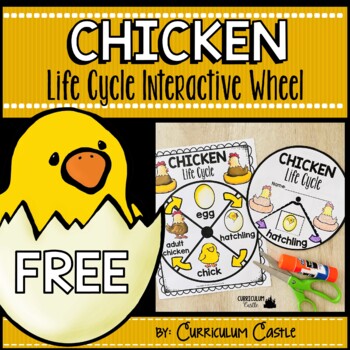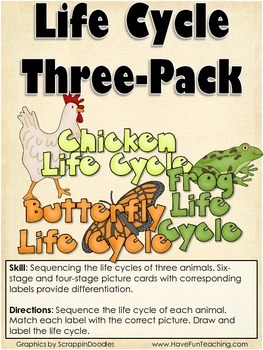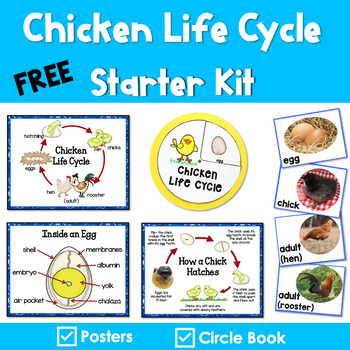One memory that stands out in my mind during my oldest's early elementary years is the experience of hatching chicks. His teacher said it was, "a dud year" and that she'd never do it again because so many didn't make it, but even so, it was truly a neat experience for him. Even 13 years later, he still remembers the chicks chirping, jumping around, and holding them, and the pictures? Sigh...just precious!
You may not jump in to hatch chicks, but the life cycles standard can lead to really great opportunities for students to witness how life cycles work and observe like a scientist. In today's post, I'll be sharing ideas you might find helpful.
Butterfly Life Cycles
 Butterflies are one of the symbols we enjoy in spring. For one, you can make some of the cutest crafts to make your classroom bright and colorful, but there are also fabulous literature options you can use to teach your science concepts too. Using text sets offers a range of reading levels to your students and allows them to access the content from multiple perspectives leading to deeper understanding. From this list, I have used Born to Be a Butterfly, Caterpillars and Butterflies, From Caterpillar to Butterfly, Waiting on Wings, Butterfly House, The Very Hungry Caterpillar, and Velma Gratch and the Way Cool Butterfly, and I LOVE them all.
Butterflies are one of the symbols we enjoy in spring. For one, you can make some of the cutest crafts to make your classroom bright and colorful, but there are also fabulous literature options you can use to teach your science concepts too. Using text sets offers a range of reading levels to your students and allows them to access the content from multiple perspectives leading to deeper understanding. From this list, I have used Born to Be a Butterfly, Caterpillars and Butterflies, From Caterpillar to Butterfly, Waiting on Wings, Butterfly House, The Very Hungry Caterpillar, and Velma Gratch and the Way Cool Butterfly, and I LOVE them all.Recently, I expanded a resource I developed for Butterfly House by Eve Bunting, and it now includes a Life Cycles Lapbook. If you haven't used these before, you might consider giving them a try. Over the course of your Life Cycles Unit, you would build the lapbook to have a complete resources for review later. We know how much our students need to revisit the science concepts to prepare for SOL testing, and if you've made lapbooks with them, you can pull them out for reference later. Below are images of the lapbooks part of the unit, but it also included guided reading materials for the book which would work well as a mentor text for comprehension skills, writing, or for small group instruction.
In addition to this resource for butterflies (and other life cycles), you might also use these other fabulous resources.
Chicken Life Cycles

If I were mapping out this unit, I believe we'd have a butterfly week, a chicken week, a frog week, and a celebrating us week. How fun would that make this unit for kids! For Chicken week, here are my book recommendations. Of all of these books, I would start with Gail Gibbon's book and refer to it throughout the unit. She THE TOP nonfiction writer in my mind. I also like Rookie Readers as they are fairly controlled with vocabulary. (If you enlarge the text set images, you could probably have your librarian help you gather them.)
Of all the free resources I saw, I just love this one from First Grade Schoolhouse. I think it'd be very useful with several nonfiction books. With it, students describe the stages of the chicken's life cycle.
My friend, Peggy Means at Primary Flourish created chicken life cycle posters for teaching too. They would work well during lessons or as part of a bulletin board. Reading diagrams is a skill kids need too, and I love how she labeled the images.
 Finally, you might grab this Life Cycle wheel to make with your students too from Curriculum Castle. The wheels could be very useful in group discussions as students could flip their wheel around to the stage that matches questions you ask.
Finally, you might grab this Life Cycle wheel to make with your students too from Curriculum Castle. The wheels could be very useful in group discussions as students could flip their wheel around to the stage that matches questions you ask. Frog Life Cycles
Well, I didn't talk about bunnies, but I'll introduce this last section with a great joke for your kids.
What do you get when you cross a frog and a bunny?
What do you get when you cross a frog and a bunny?
(A ribbit!)
 There is no shortage of frog books lucky for us. Why? Well, I think kids are just fascinated by them, and I think most libraries are plentiful with frog books which helps. I would recommend putting your text sets into a basket for the kids to pull from during the time you're working on this unit, but I would keep them grouped for later too. You know they'll return to them for a second look. The books by Nic Bishop are probably my favorites from all three of these collections. If you've ever seen his books, the photography is easy to pick out. How he grabs the shots he does is beyond me! Gail Gibbons also has a book about frogs, and you'll appreciate how well she explains and illustrates the frog's life cycle. Finally, you can tie in fictional books such as the classic Frog and Toad books by Arnold Lobel. These work well because they're at a second grade level, and life cycles hits at the second grade level in Virginia.
There is no shortage of frog books lucky for us. Why? Well, I think kids are just fascinated by them, and I think most libraries are plentiful with frog books which helps. I would recommend putting your text sets into a basket for the kids to pull from during the time you're working on this unit, but I would keep them grouped for later too. You know they'll return to them for a second look. The books by Nic Bishop are probably my favorites from all three of these collections. If you've ever seen his books, the photography is easy to pick out. How he grabs the shots he does is beyond me! Gail Gibbons also has a book about frogs, and you'll appreciate how well she explains and illustrates the frog's life cycle. Finally, you can tie in fictional books such as the classic Frog and Toad books by Arnold Lobel. These work well because they're at a second grade level, and life cycles hits at the second grade level in Virginia. For materials, you could use these freebies.



In addition to these printables, I thought this short video clip was amazing. Live action shots just amaze kids, and I love that they give a visual illustration of the life cycle for them to watch/understand.










This is a great post! I can't wait to use it and share it!
ReplyDeleteThanks so much!
DeleteWonderful post! Teaching the butterfly life cycle is my favorite science unit and these are some great book recommendations! Thanks for sharing!
ReplyDeleteJackie
Neat Sweet & Hard to Beat
Thanks Jackie! I'm glad it'll help you out. The freebies from Primary Flourish are great for this unit. :-)
DeleteThis will be so helpful for my life cycle unit! Great post! Thanks!
ReplyDeleteSo glad to hear it, Pam.
Delete